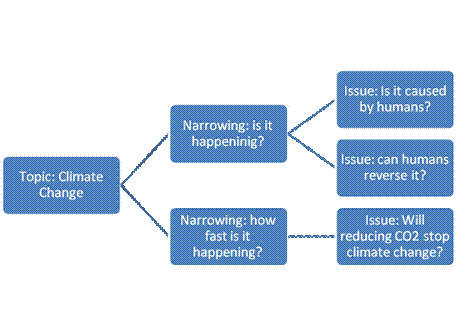Day 11 (Friday, September 18th)
Day 11 (Friday, September 18)
Lesson Objectives
Students will discuss the rhetorical situation of the The 11th Hour Movie
understand the difference between a topic and an issue
Prep
If you haven’t yet seen the movie, you might attend the campus viewing. You might review the movie either way and take some critical notes to inform you class discussion. On the movies website, http://wip.warnerbros.com/11thhour/ you’ll find a comprehensive list of topics that the movie covered.
Materials
Movie notes
Notes on topics vs. issues
Lead-in
Check in with students about the critical reading work—be sure they understand that they need to turn in one double-entry log and a rhetorical situation movie guide with their Assignment 2 process work. Now that students have had a chance to practice both, they can discuss which they prefer, and why.
Activities
Attendance and Introduction (2-3 minutes)
Take attendance and introduce class as usual.
Discuss The 11th Hour Movie (20-25 minutes)
Ask students to take out there Rhetorical Situation Movie Guide to refer to in the class discussion. At this point in the class students should begin to make intertextual connections between the readings, films, and soon, the blogosphere. One way to begin making these connections is to identify topics within the green rhetoric conversation, and current debatable issues within those topics? The movie provides a rich list of possible topics to discuss within the conversation.
Use the tree below to convey to students how to distinguish between a topic and an issue. This is also a good time to encourage them to move their abstract thinking into the more specific realm where inquiry takes place.
Use the table to get students to come up with the current debatable issues within the broader topics.
Topic Narrowing Issues Issues

Topics: The following are topics covered in The 11th Hour |
Issues: Within our rhetoric of green inquiry, what is being said—what debates, questions, and frames—within these topics, either in the movie or our other texts. |
Environment and ecoliteracy |
Issues: |
Human thinking and human capacity |
Issues: |
Fresh water |
Issues: |
Oceans |
Issues: |
Air pollution |
Issues: |
Forests and lands |
Issues: |
Species & biodiversity |
Issues: |
Human health |
Issues: |
Environmental justice |
Issues: |
Civil society civilizations collapse |
Issues: |
OIL |
Issues: |
Economy and corporations |
Issues: |
Consumers and media |
Issues: |
Sustainable design |
Issues: |
Renewable energy |
Issues: |
Solutions from nature |
Issues: |
Individual action |
Issues: |
Religious perspectives |
Issues: |
Synthesis (8-10 minutes)
To complete this discussion ask students to look at some of the issues they came up with and think about the other texts they’ve read or viewed. Can they make some connections? Connections are happening at the topic level and at the issue level. Make sure students recognize the difference. For instance, over-consumption might be a topic addressed by multiple texts, but what people are suggesting we do about it might vary between texts (issue level).
Discussion: Clarifying Assignment 2 Goals (5-10 minutes)
One area where students will have confusion in this assignment is in determining the difference between initiating a critical discussion and making an argument. While their discussion might have minor contentions, it will not have an informed stance on a current debatable issue, backed up by logical reasoning and credible evidence (all in due time!) Rather this assignment asks students to gather bits of the conversation from different sources we’ve read/viewed and connect them in an engaging way that will enhance our understanding of the polyphony within the rhetoric of green. This exercise will begin to clarify the students’ purpose.
One way to split up the rhetoric at this point is by distinguishing between the rhetoric of problem and the rhetoric of solution. In other words, how do the various texts frame the problems within the rhetoric of green, and how do they frame the solutions.
Problems: How are these being portrayed? |
Solutions: How does the movie frame solutions? |
Solutions: How do other texts frame solutions? |
|
|
|
Intertextual Connection Example: Quinn says that humans have to change their way of thinking in order to be able to solve some major environmental problems. Did any experts in the movie say something similar?
Assign homework and conclude class (2-3)
Take time today to reiterate the importance of 1) having internet access for homework assignments, since we’ll be moving into analyzing blogs 2) bringing thorough notes to class, since you won’t have the blogs and films on hand.
Homework for Monday
Connection to Next Class
Today's class helped students begin to make important connections between the texts. Make sure that you continue to reinforce this synthesis as students struggle with “what to say,” in continuing the conversation assignment. You might remind students that you plan on returning their first major assignment on Monday, though don’t go so far as to make promises, since none of us can foresee extenuating circumstances that could prevent the assignment’s return.